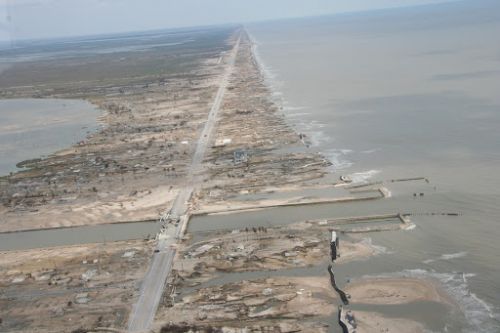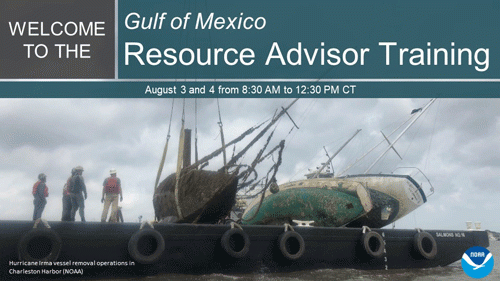Fiscal Year 2022: Preparedness for Natural and Human-Caused Disasters
The Disaster Preparedness Program (DPP) coordinates current operational capabilities and facilitates knowledge from across the National Ocean Service (NOS) and NOAA to ensure that commerce, communities, and natural resources can recover as quickly as possible. The DPP includes NOAA’s Gulf of Mexico Disaster Response Center, located in Mobile, Alabama, which is a fully staffed facility that expands the federal capacity to plan for and respond to hazards of all types in the five states bordering the Gulf of Mexico.
The program is dedicated to providing services that allow NOS and our partners to move through the preparedness cycle efficiently, safely and effectively—including creating and modifying NOS emergency plans for continuity of operations, providing training and exercises to improve preparedness and response posture, and serving in an incident coordination role during natural disasters and other emergencies.
Disaster Preparedness for Coastal Communities
Partnerships are critical to NOAA’s success in disaster preparedness. This year, the Office of Response and Restoration embarked on a new partnership with the National Sea Grant Office in NOAA’s Office of Oceanic and Atmospheric Research. Sea Grant programs are well positioned to support their communities given their proximity to and familiarity with the needs of those they serve.
OR&R and Sea Grant established a new funding opportunity for their programs that would improve disaster preparedness within coastal communities. A new special projects competition will provide funding for projects that address preparedness gaps or needs of the community to enable them to reduce disaster impacts and reach recovery more quickly. Sea Grant announced the selection of three projects led by Hawai’i, MIT, and Wisconsin Sea Grant programs that will receive a total of $540,000 over two years. These projects will benefit vulnerable communities by helping them plan for, respond to, and recover from flooding, sea level rise, and oil spill impacts to aquaculture. Disasters will continue to impact the communities we serve, but when we work together, we are able to maximize our impact and help improve the outcome for those affected.
Providing Funding Opportunities to Enhance NOS Preparedness
The Annual Lagniappe Funding provides limited funding opportunities that enhance NOS preparedness and mission readiness for natural and human-caused disasters. In FY22, nine projects were awarded to promote a readiness culture across NOS. This is the third year the Office of Response and Restoration has solicited proposals and funded projects. In FY22, the office also observed and exercised projects previously funded by Lagniappe awards.
The Office for Coast Survey demonstrated their remotely operated uncrewed surface vessel system, the EchoBoat 240. The EchoBoat 240 greatly improved the efficiency, safety, and accessibility of survey operations in shallow or obstructed waters. It augments their Navigation Response Team crewed vessels and Mobile Integrated Survey Team kit.
In addition, OR&R and the Center for Operational Oceanographic Products and Services (CO-OPS) partnered to exercise the Real-Time Currents and Meteorological Buoys (affectionately known as CURBY). The systems were built to be rapidly deployed by a relatively small vessel if a fixed monitoring station was damaged and there was a need for real-time data. The exercise included a series of informative sessions that featured the tools and data available from NOAA CO-OPS, an introduction to the CURBY system, and steps necessary for deployment, including expert guidance for environmental compliance activities.
Increasing Capacity for Response, Assessment, and Restoration through Training
OR&R is a leader in providing valued and timely training internally to NOAA and externally to our state, federal, industry, and other nongovernmental partners and stakeholders. The OR&R Training Team is made up of representatives from each of the divisions within OR&R to ensure cross-divisional training and coordination. Training is offered that enhances capacity for response, assessment, and restoration related to the OR&R mission.
With continued limited ability to have in-person training, OR&R continued to restructure courses into a virtual classroom environment. In August of 2022, OR&R held the Gulf of Mexico Resource Advisor Training virtually. The goal of this course was to ensure coastal managers understand the role of a resource advisor and have the tools necessary to fulfill the role in the field successfully. By coordinating with subject matter experts from multiple agencies in the course design and delivery, the course provided lectures covering the roles and responsibilities of a resource advisor, tools that can be used in the field, best management practices, environmental trade-offs, and salvaging techniques. Over 90 participants attended the training representing local, state, and federal agencies from across the Gulf of Mexico Region.
 An official website of the United States government.
An official website of the United States government. 


